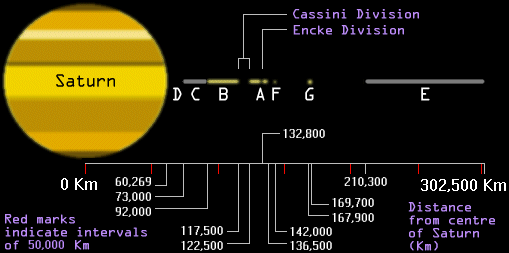Saturn
![]()
Saturn is the second largest planet in the Solar System, and is known mainly for its wonderful ring system, shown in the image below (which is a mosaic composed of images from the Cassini spacecraft, currently in orbit around Saturn).

[ NASA / JPL / Caltech ]
| Siderial Period |
Perihelion (AU) |
Aphelion (AU) |
Inclination (degrees) |
Axial Tilt (deg) |
Axial Period (d, h, m) |
|---|---|---|---|---|---|
| 29.46 y | 9.01 | 10.04 | 2.5 | 26.73 | 0, 10, 39.4 |
| Equatorial Diameter (km) |
Oblateness | Mass (Earth = 1) |
Density (water = 1) |
Albedo (geom.) |
No. of Satellites |
| 120, 537 | 0.108 | 95.16 | 0.7 | 0.47 | 18 + R |
Ring system
The ring system is divided into several distinct bands, and contains two major gaps in the structure, called the Cassini division and the Encke division. The cross-section below illustrates the ring system to scale (in terms of radial distance from the centre of Saturn). Rings A, B and C are the only ones visible from Earth - the others were imaged or detected by Pioneer 11 and the two Voyager spacecraft when they conducted their fly-bys. (Based on a diagram in Kaufmann, 1994.)

Several satellites orbit within Saturn's ring system. Pan orbits in the Encke Division (see diagram above); Atlas and Prometheus orbit in the gap between rings A and F; Pandora orbits just outside ring F; Epimetheus and Janus orbit around 9,000 Km further out than Pandora; Mimas orbits around 17,000 Km beyong ring G; Enceladus orbits about 28,000 Km from the inside edge of the E ring, and Tethys, Calypso and Telesto orbit another 57,000 Km out, 7,500 Km from the outer edge of the E ring.
Here are two links to NSSDC images of the ring system. The first shows the 'spokes' and that there are rings present in the Cassini Division, and the second shows good detail of the faint inner C ring. Both images were taken by Voyager 1.
Missions to Saturn
For a list of missions to Saturn see the links page.